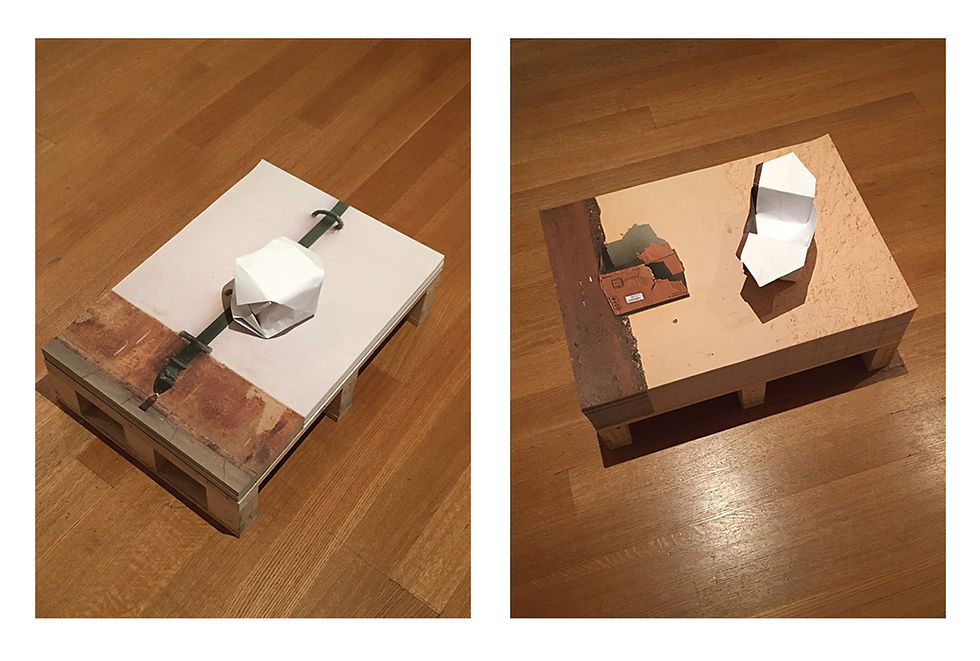
An experimental opera and multimedia installation about coral reefs and climate change presented at SMUSH Gallery, Jersey City, NJ, March 3 - April 2, 2023.
The tiny polyps that make up the living structure of a coral reef may only live a few years, but the colony it creates can continue to grow and reproduce for thousands of years. The resultant reefs that are created from the various structures of coral form an ecosystem that support nearly 25% of the world’s ocean animals. The reef colonies are vital communities of biodiversity. The rocky growths surround islands and coastlines to form barriers that calm ocean violence and protect beaches against erosion.
Unfortunately, these coral reefs are also fragile and under threat from pollution, ocean warming, ocean acidification, overfishing, recreational boating, and the very tourists who want to enjoy them. Nearly a billion people worldwide depend on coral reefs for their livelihoods. Yet it is expected that 90% of all existing reefs could die by 205opera1. This worldwide disaster would negatively impact everyone on the planet.
The immensity and urgency of this challenge is the inspiration for Once She Dries. The collective of artists involved in the production are sounding an alarm. To do so, they’ve harnessed the value and function of science — and of myth. They’ve seduced us with song, enveloped us in undulating waves, and affirmed our sense of mystery and awe as we confront and engage with our planet through their multidisciplinary installation. They’ve teased out a tale that recognizes love as its ideal while embracing science as a divine entity. The cosmos swirls in a coral reef and we will be judged on how we proceed.
The gods managed chaos. They might have been as fickle as we mere mortals, but at least we could better understand the vagaries of fate, the cost of vanity, of love, courage, and jealousy through them. The mysteries of the universe were better navigated with the instructive benefit of their mythology. But science decided there was another path to understanding ourselves and the world around us. Science claimed reliability and accuracy. The ways of nature and society could be observed, measured, and understood with systematic study and experimentation. Science was less likely to be corrupted by passion. The gods and goddesses are a passionate lot. Yet, science knows of no absolute truth. Every scientific theory has a provisional dimension. Perhaps that’s the trade off — the passionate vs. the provisional.
The libretto of Once She Dries tells the story of a coral reef in peril, in desperate need of shade and cooling. The reef’s plaintive cry ascends from the ocean floor and releases a cloud-producing vapor. The cloud is charged with finding the nourishment the reef requires. Their bond — the coral, the cloud — and their commitment to each other will bring healing. It is an expression of love. But the way forward isn’t without treachery. All the gods have been eavesdropping. The largest cast concrete dome, home to all the gods — the Pantheon — has become the keeper of the reef. (Coral was once mined for lime to give cement its solidity.) Coral has been trapped under the dome, like Danaë shut up in her bronze chamber, or Eurydice consigned to Hades. What heroic intervention will free Coral?
Once She Dries offers a cautionary flood of hope. Science has rightly put us on high alert. We are stewards of the planet. Charged with its care, we’ve failed time and again. We’re turned a blind eye to poisonous activities. If we implement regulations here, transgressions over there can be ignored, it’s a convenient self-delusion. Our rivers are the birthplaces of civilizations and our oceans and seas feed and regulate every aspect of our wellbeing. Once She Dries is a cris de coeur, a new mythology of science that makes palpable a crisis of global proportion. Data is a cold tool, stark in its utility. The gods of myth with their wayward passions have a keen function too. The artists of Once She Dries suggest the union of the two may prove the way towards our salvation.

© 2023
1 Forbes, February 24, 2020, “Nearly All Coral Reefs Will Disappear Over The Next 20 Years, Scientists Say” by Trevor Nace
"Science, Myth, Life and Love," is the catalog essay for the exhibition Once She Dries. It was commissioned from Arthur Bruso and Raymond E. Mingst by the collaborators of the production. The collaborators of Once She Dries are: Megan Woods, story; Nancy Cohen, installation; Xinyue Liu, video; Casper Leerink, piano and sound engineering; Kourosh Ghamsari-Esfahani, violin, sound editing; Amanda Sum, vocals.










